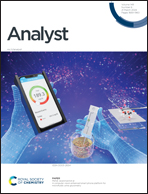Advancing carbohydrate quantification in MALDI mass spectrometry by the rapidly freeze-drying droplet (RFDD) method†
Abstract
Quantitative carbohydrate analysis faces challenges in matrix-assisted laser desorption/ionization mass spectrometry (MALDI-MS), including insufficient sensitivity and inconsistent spatial distribution of ion intensity. This study introduces an innovative sample preparation approach, the Rapidly Freeze-Drying Droplet (RFDD) method, aimed at overcoming these challenges by enhancing the homogeneity of the sample morphology and signal intensity in MALDI. Compared to conventional preparation methods, the RFDD method reduces the laser energy threshold and demonstrates a remarkable increase in signal intensity for carbohydrates, facilitating the detection of high-molecular-weight polysaccharides (>10 kDa). The RFDD-prepared samples exhibit a uniformly distributed signal intensity that overcomes the ‘sweet spot’ issue in MALDI. The enhanced signal intensity and reproducibility lead to reliable quantitative analysis of carbohydrates, eliminating the need for expensive isotopic standards in each sample. A straightforward and accessible approach is presented for general laboratories, revolutionizing carbohydrate analysis in MALDI-MS.

- This article is part of the themed collection: Analyst HOT Articles 2024


 Please wait while we load your content...
Please wait while we load your content...